As a musician and teacher with over 14 years experience, I’ve taught a hundreds of pupils to play minor scale. This article provides detailed fingering charts for all flute harmonic minor scales and my top tips to guide players through practice
Flute Harmonic Minor Scales
A Harmonic Minor
Notes: A, B, C, D, E, F, G#, A
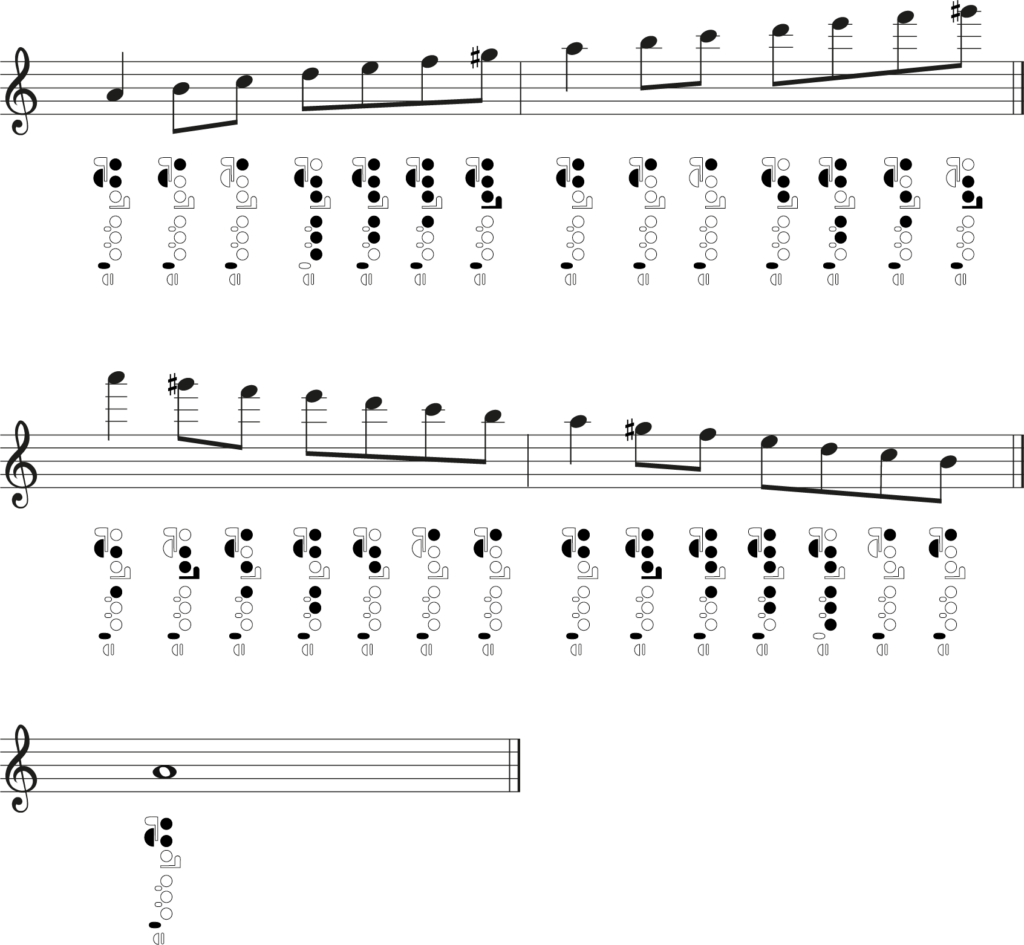
Flute harmonic minor scales- top tips for A harmonic minor:
- Smooth transitions between E and F, and G# and A: Practice these fingering changes slowly, using a metronome to ensure even timing. Gradually increase speed as you become more comfortable and the transitions smoother.
- Intonation for G# and D tends sharp: Play these notes with a tuner to monitor intonation. Adjust embouchure slightly and focus on air support to bring these notes into tune, practicing both in isolation and within the scale.
- Maintaining consistent tone across octaves: Focus on embouchure flexibility and steady air flow. Practice octave jumps slowly, paying attention to the stability of the tone, and use breath support exercises to enhance control.
E Harmonic Minor
Notes: E, F#, G, A, B, C, D#, E
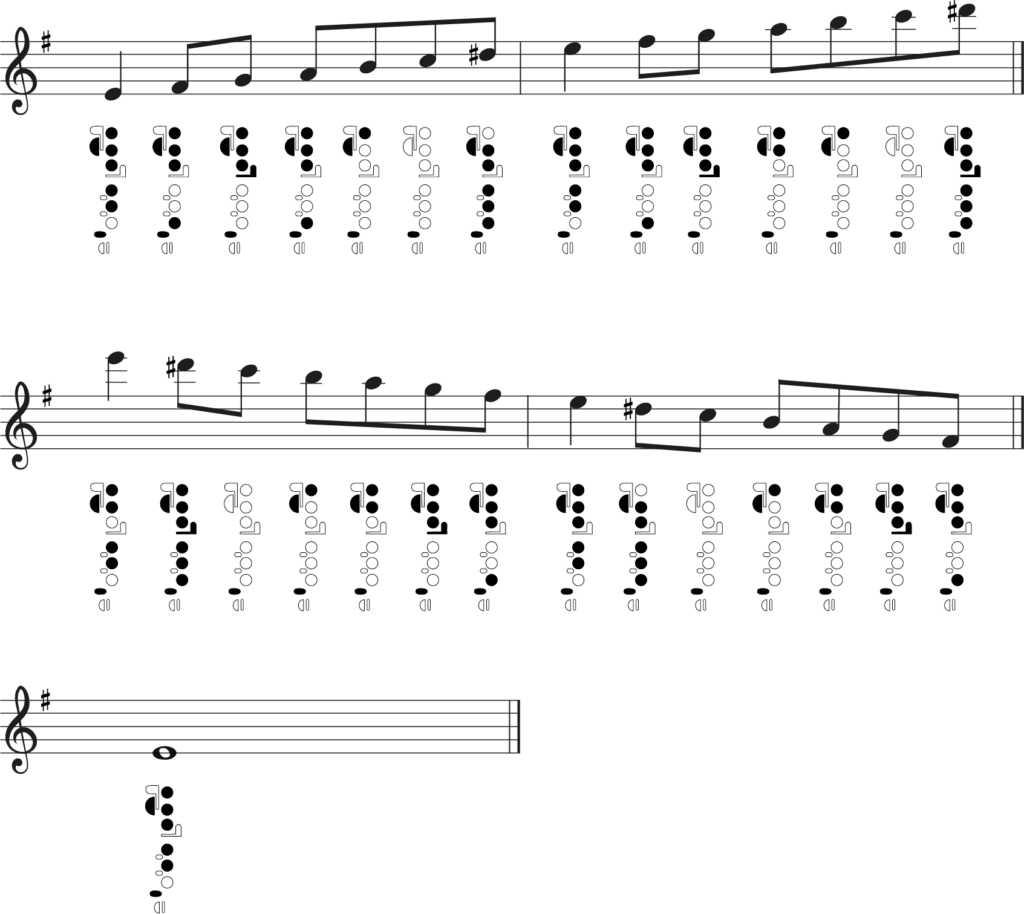
Flute Harmonic Minor Scales- Top tips for E harmonic minor:
- Smooth Transition Over the F# to G Jump: Work on the transition between F# and the raised G note, which can be tricky due to the half-hole fingering for F#. Practice moving between these notes slowly, focusing on minimizing the movement and ensuring a seamless transition, then gradually increase the tempo.
- Tuning the Raised 6th (C#): The C# in the E harmonic minor scale can tend to be sharp. Use a tuner to practice this note, both in isolation and within the context of the scale, adjusting your embouchure or air direction to correct the pitch.
- Maintaining Tone Quality on the High D#: The high D# (the raised 7th) can be challenging in terms of tone quality and intonation. Practice this note slowly, focusing on embouchure flexibility and air support to maintain a rich tone, then incorporate it into the scale, aiming for evenness across the entire range.
B Harmonic Minor
Notes: B, C#, D, E, F#, G, A#, B
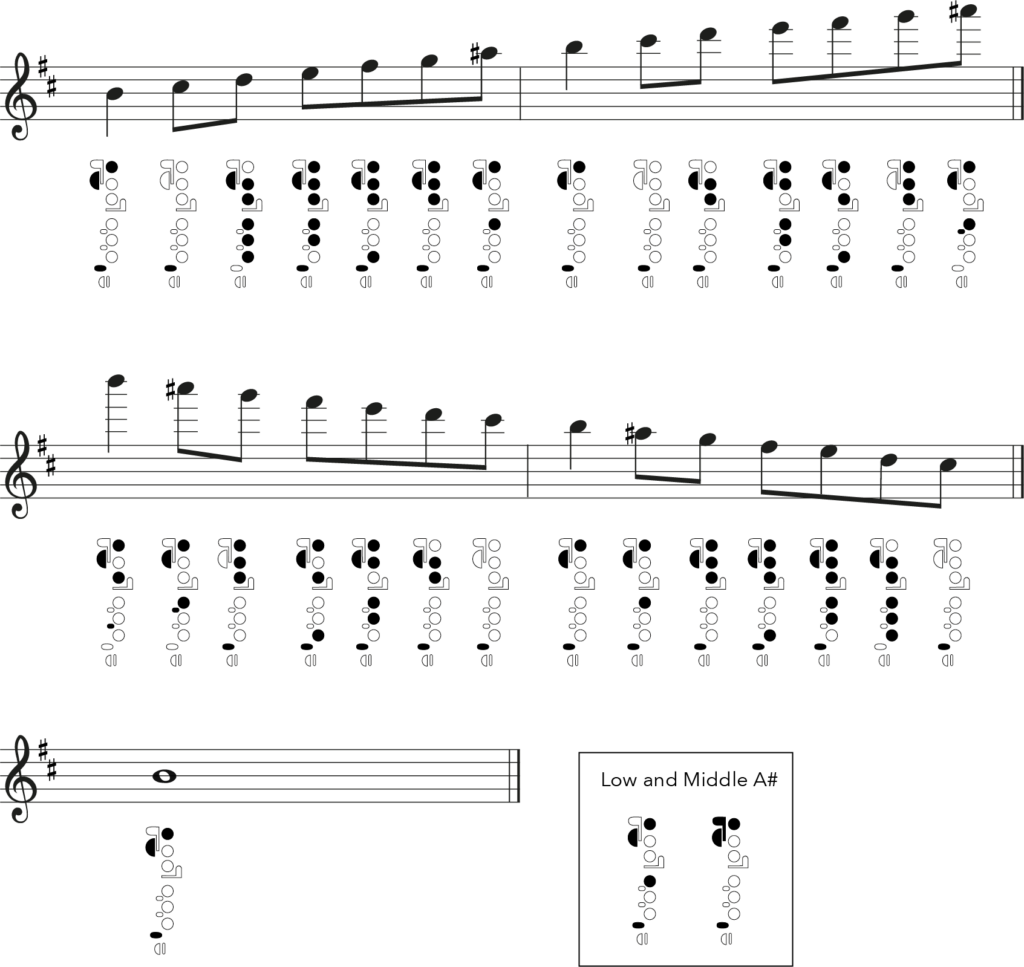
Flute harmonic minor scales- Top tips for B harmonic minor:
- Accurate Fingering for A#: Practice the fingering for A# in isolation, focusing on the transition from A to A# and back. This note often requires precise fingering, especially when played in rapid succession within the scale. Slowly practice the scale around these notes, gradually increasing speed as your fingers become more agile and accurate.
- Intonation of the Raised 7th (A#): The A# note can easily sound sharp, particularly in the upper octave. Use a tuner to practice this note in isolation, adjusting your embouchure and air flow to fine-tune its pitch. Then, play it within the scale to ensure it blends well with the surrounding notes.
- Even Tone Across Octave Leaps: The leap from the lower B to the higher B, and particularly from A# to B in the upper octave, can challenge your tone consistency. Focus on maintaining steady air support and a relaxed embouchure through these leaps. Practice octave jumps on these notes, aiming for a smooth and controlled sound transition.
F Sharp Harmonic Minor
Notes: F#, G#, A, B, C#, D, E#, F#
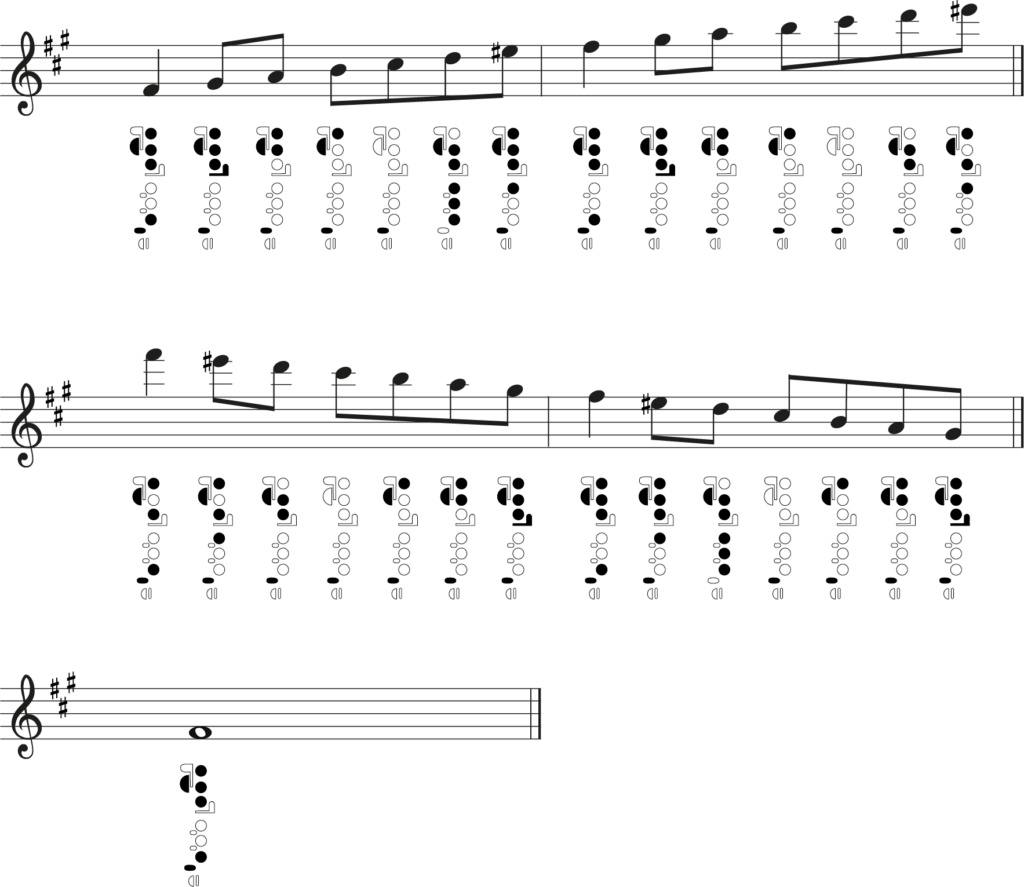
Flute Harmonic Minor Scales- Top tips for F# harmonic minor:
- Navigating F# to G# Transition: The half-step between the F# and the raised G# in the lower octave can be tricky due to the fingerings. Practice this transition slowly, focusing on precise finger movement to ensure smoothness. Gradually increase the speed as your comfort with these fingerings improves.
- Tuning the Raised 7th (E#): The E# (enharmonically F natural) can be challenging to tune, especially within the context of the scale where it functions as a leading tone back to F#. Use a tuner to practice hitting the E# accurately, adjusting your embouchure to ensure it doesn’t sound flat compared to the F#.
- Consistent Tone Quality in Upper Register: The high E# and the transition back to F# in the second octave demand careful control of air support and embouchure to maintain tone quality. Practice these high notes slowly, focusing on supporting with your air and keeping a stable embouchure.
C sharp Harmonic Minor
Notes: C#, D#, E, F#, G#, A, B#, C#
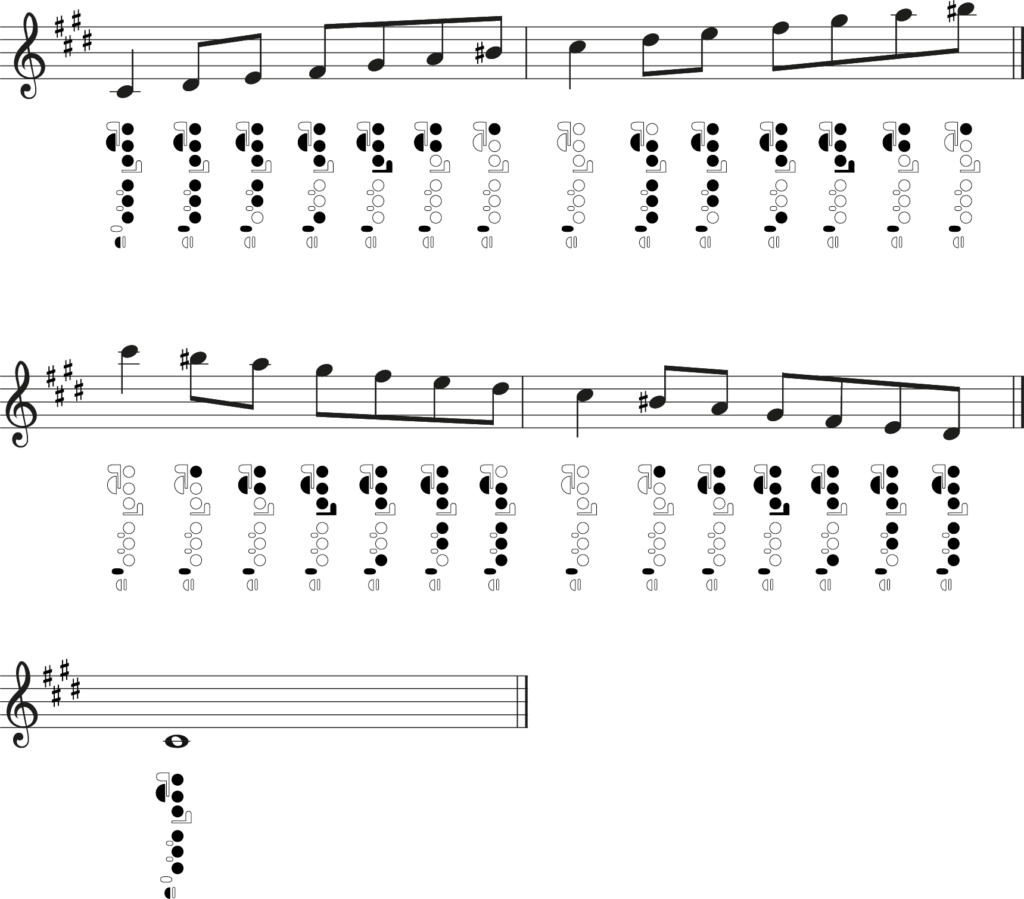
Flute Harmonic Minor Scales- Top tips for C# harmonic minor:
- Smooth Transition Between B and C#: Practice moving between B and the raised C# carefully, focusing on clean finger action to ensure a smooth scale. This transition can be awkward because of the change in hand position needed to play C# accurately. Slow practice focusing on the transition can help improve fluidity.
- Intonation of the Raised 7th (B#): The B# (enharmonically C natural) can be challenging to intonate, especially when ascending to the high C#. Use a tuner to practice this note in isolation, making slight adjustments to your embouchure to correct pitch.
- Maintaining Tone Quality on High Notes: The high B# and C# can test your control over tone quality and intonation. Focus on embouchure flexibility and steady air support to maintain a consistent sound.
G Sharp Harmonic Minor
Notes: G#, A#, B, C#, D#, E, Fx (or G), G#
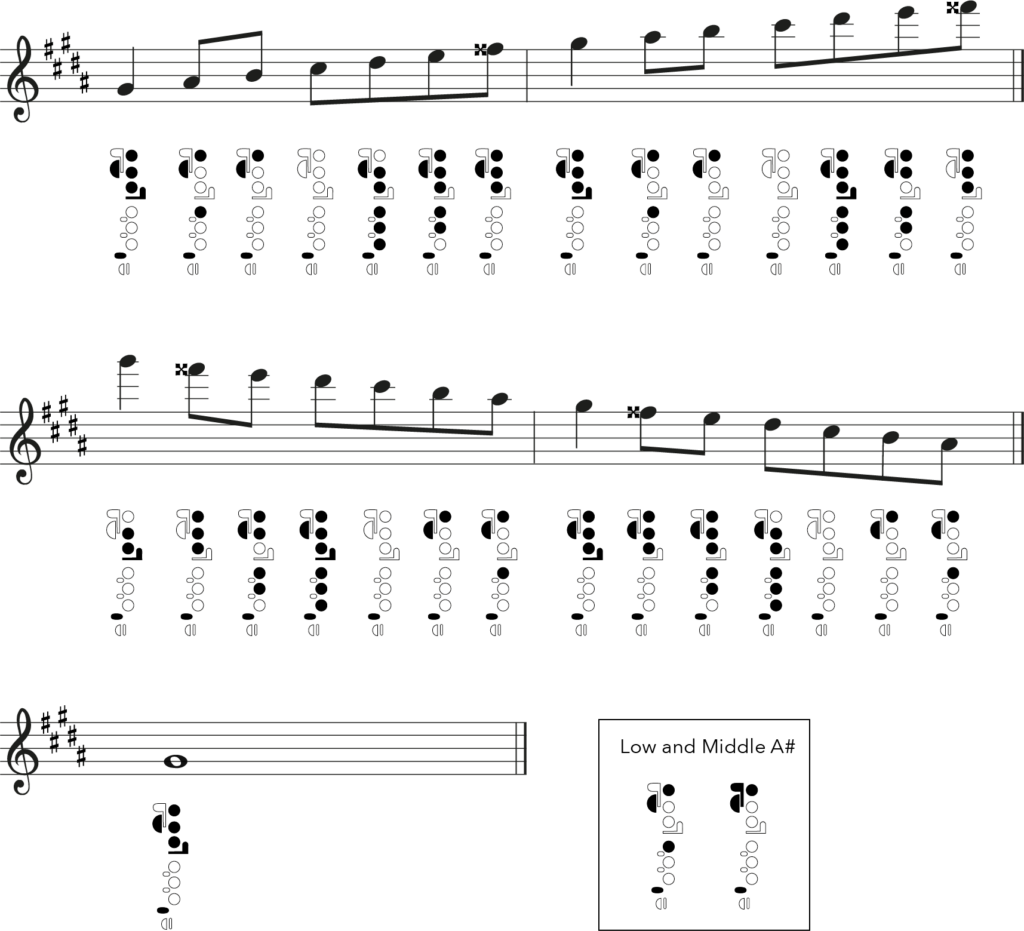
Flute harmonic minor scales- Top tips for G# harmonic minor:
- Accurate Fingering for Fx (F double sharp, enharmonically G): The transition between Fx (enharmonically G) and G# can be challenging due to the unusual fingering for Fx. Practice this transition slowly, focusing on accurate fingering and smooth movement between these notes. Gradually increase the speed as you become more comfortable and the transition smoother.
- Tuning the Raised 7th (Fx): The raised 7th degree, Fx, can be difficult to intonate correctly since it’s enharmonically a G natural, a note not typically played in this context on the flute. Use a tuner to practice hitting the Fx accurately, adjusting your embouchure as needed to ensure it is in tune, especially when moving to the G#.
- Consistent Tone Quality across Octaves: The leap from the lower G# to the higher G# and managing the tone quality for the Fx to G# transition in the upper octave requires careful control over embouchure and air support. Practice octave jumps focusing on smooth, controlled air flow and a stable embouchure to maintain a consistent tone.
D Sharp Harmonic Minor
Notes: D#, E#, F#, G#, A#, B, Cx (D), D#
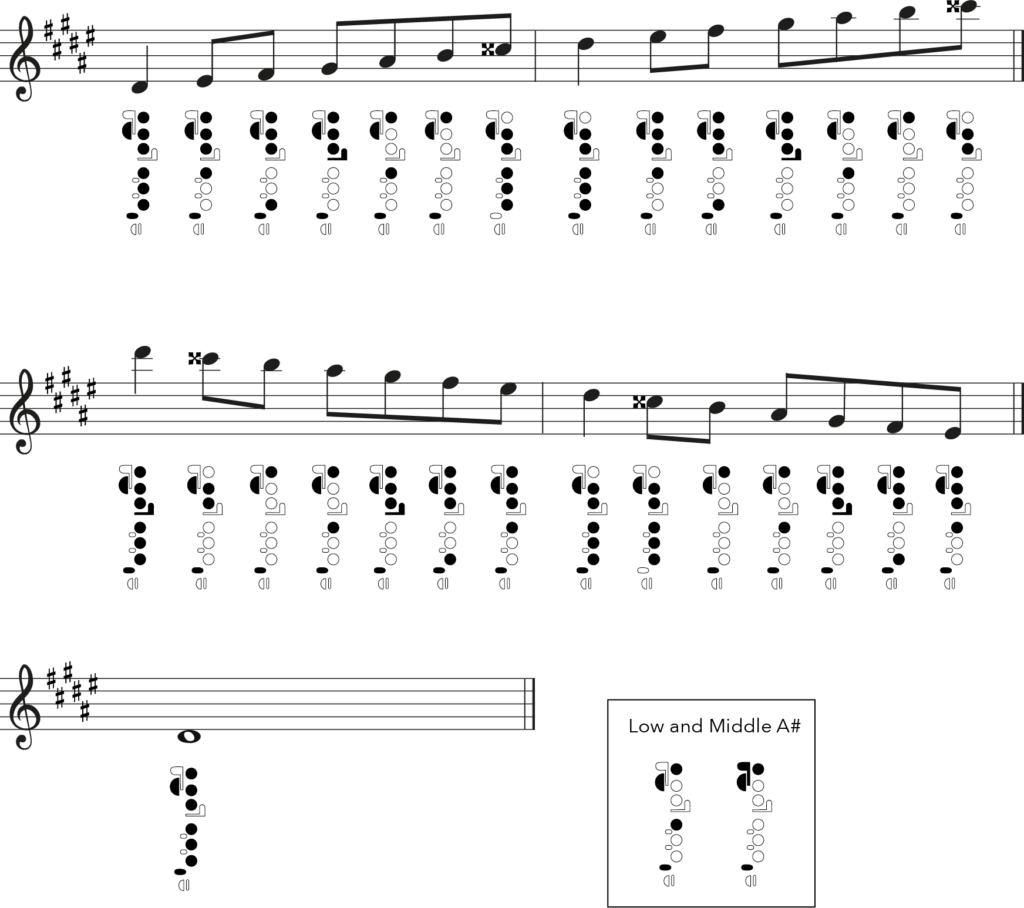
Flute Harmonic Minor Scales: Top tips for D# harmonic minor:
- Smooth Transition Between C# and D#: Practice the transition from C# to the raised D# (E♭), focusing on minimizing finger movement noise and ensuring a seamless scale. This step can be awkward due to the fingerings involved. Start slowly, emphasizing the accuracy of the transition, and gradually increase the speed as you become more comfortable.
- Tuning the Raised 7th (C#): The raised 7th, C#, can tend to sound sharp, especially when approached from the lower notes of the scale. Use a tuner to practice this note in isolation, making slight adjustments to your embouchure and air support to correct the pitch. Then, practice the note within the scale, ensuring it blends well with the overall tonality.
- Maintaining Tone Quality on High Notes: The high D# and the leap back to D# in the upper octave challenge both intonation and tone quality. Focus on embouchure flexibility and consistent air support to maintain a rich, even tone across the leap.
D Harmonic Minor
Notes: D, E, F, G, A, B♭, C#, D
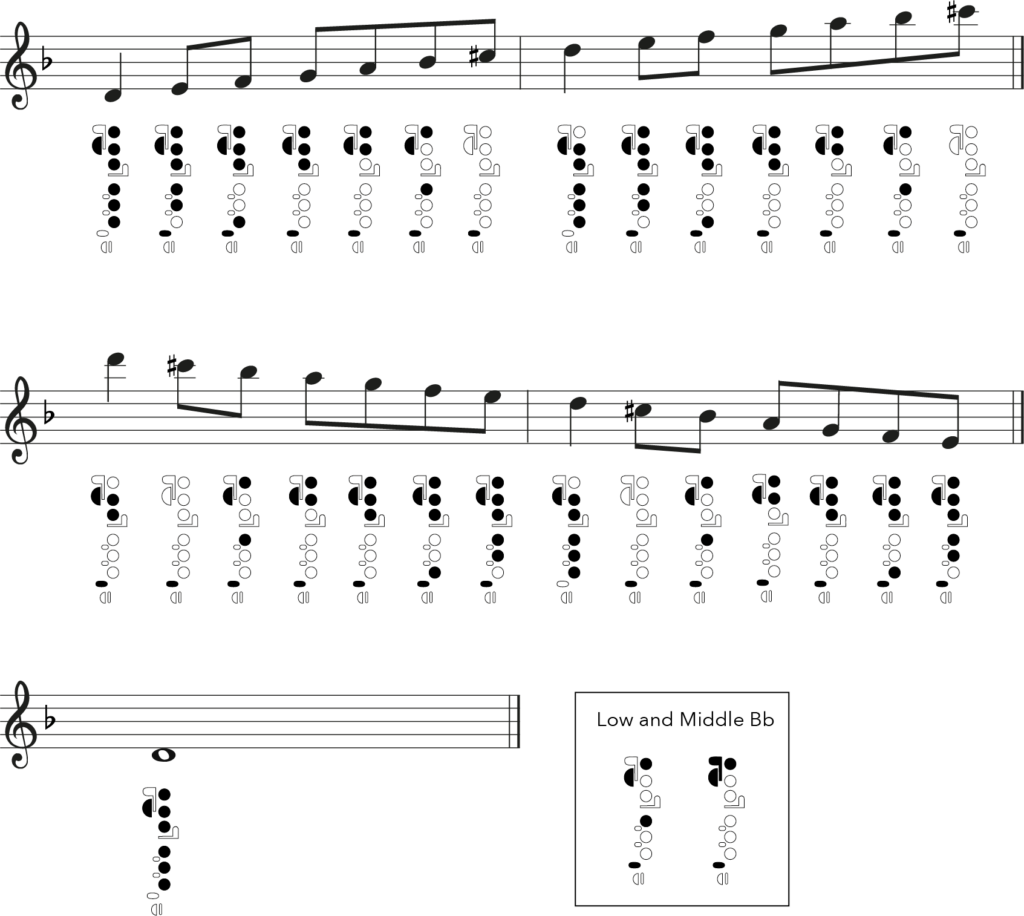
Flute Harmonic Minor Scales- Top tips for D harmonic minor:
- Accurate Fingering for C#: Focus on the precise fingering for the raised 6th, C#, which is crucial for a smooth transition in the D harmonic minor scale. Practice moving from Bb to C# and then to D, ensuring clean, crisp transitions. Begin slowly to ensure accuracy and gradually increase the tempo as your fingers become more adept.
- Tuning the Raised 7th (C#): The C# note, being the raised 7th, can be tricky to tune, particularly when transitioning from Bb. Use a tuner to practice the C# in isolation, adjusting your embouchure to fine-tune its pitch. Then, practice it within the context of the scale, paying close attention to its intonation relative to the other notes.
- Maintaining Even Tone across the Scale: Ensure consistent tone quality and volume across the scale, especially when transitioning through the octave leap from D to D. Practice supporting the air flow with steady breath control, focusing on smooth transitions.
G Harmonic Minor
Notes: G, A, B♭, C, D, E♭, F#, G
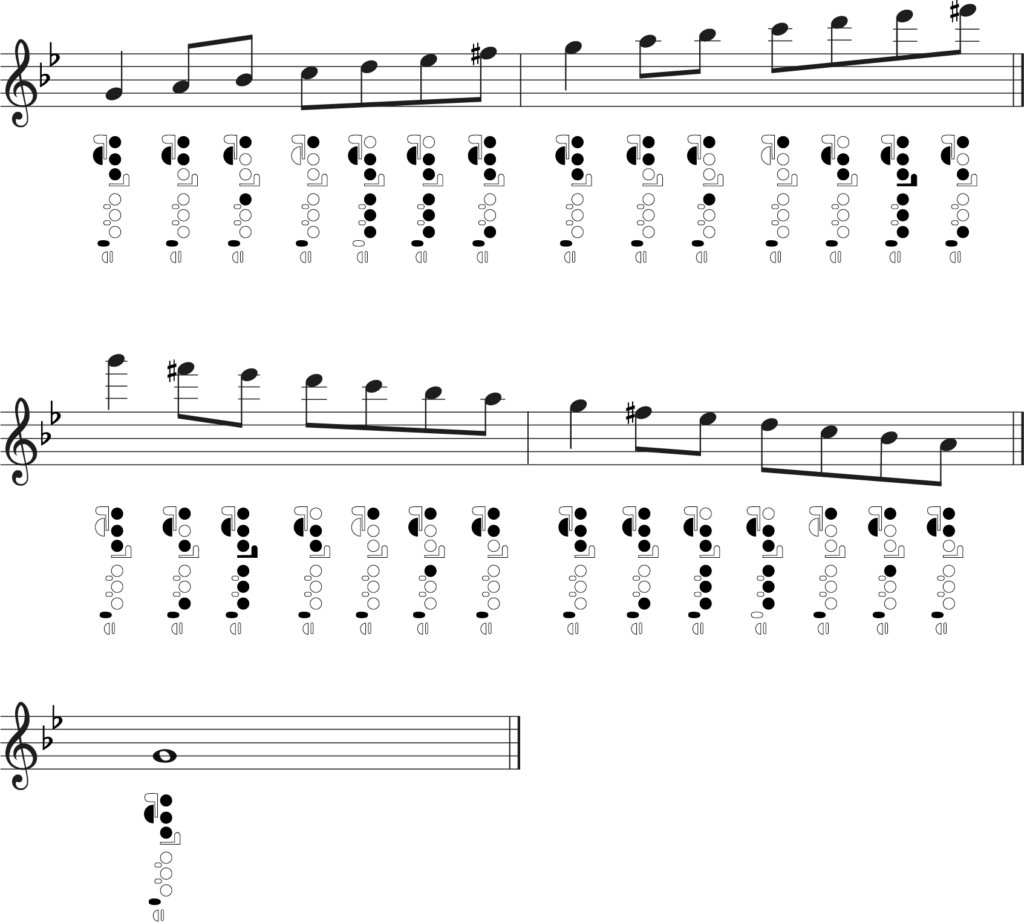
Flute Harmonic Minor Scales- Top tips for G harmonic minor:
- Smooth F# to G Transition: The leap from F# to the tonic G in the G harmonic minor scale requires careful fingering to maintain smoothness. Practice this transition slowly, focusing on clean finger movements. Gradually increase the speed as your accuracy improves, ensuring the transition remains smooth at faster tempos.
- Tuning the Raised 7th (F#): The F# note, as the raised 7th, can easily become sharp. Use a tuner to practice this note in isolation, adjusting your embouchure and air flow to bring it into tune. Then, practice the F# within the scale, paying special attention to its intonation, especially in the upper octave.
- Consistent Tone Quality in Upper Register: The upper register, particularly the high G and above, can challenge your tone consistency. Focus on embouchure flexibility and controlled air support to maintain a rich, even tone across the scale.=
C Harmonic Minor
Notes: C, D, E♭, F, G, A♭, B, C

Flute Harmonic Minor Scales- Top tips for C harmonic minor:
- Accurate Eb Fingering: The transition between D and Eb in the C harmonic minor scale is critical for smoothness. Practice this specific transition slowly, focusing on precise finger movement to ensure a seamless sound. Gradually increase tempo as you gain confidence and accuracy.
- Tuning the Raised 7th (B): The B natural, as the raised 7th, can be challenging to intonate, especially when moving from Ab to B. Use a tuner to practice the B note in isolation, making slight embouchure adjustments to correct its pitch. Then integrate this note into the scale, focusing on its blend and intonation within the context.
- Maintaining Tone Quality Across Octaves: Ensure consistent tone quality when transitioning from the lower octave C to the higher octave C, and through the scale’s range, particularly over the break. Practice supporting with steady air flow and maintaining a relaxed embouchure to achieve a smooth and even tone across the scale.
F Harmonic Minor
Notes: F, G, A♭, B♭, C, D♭, E, F
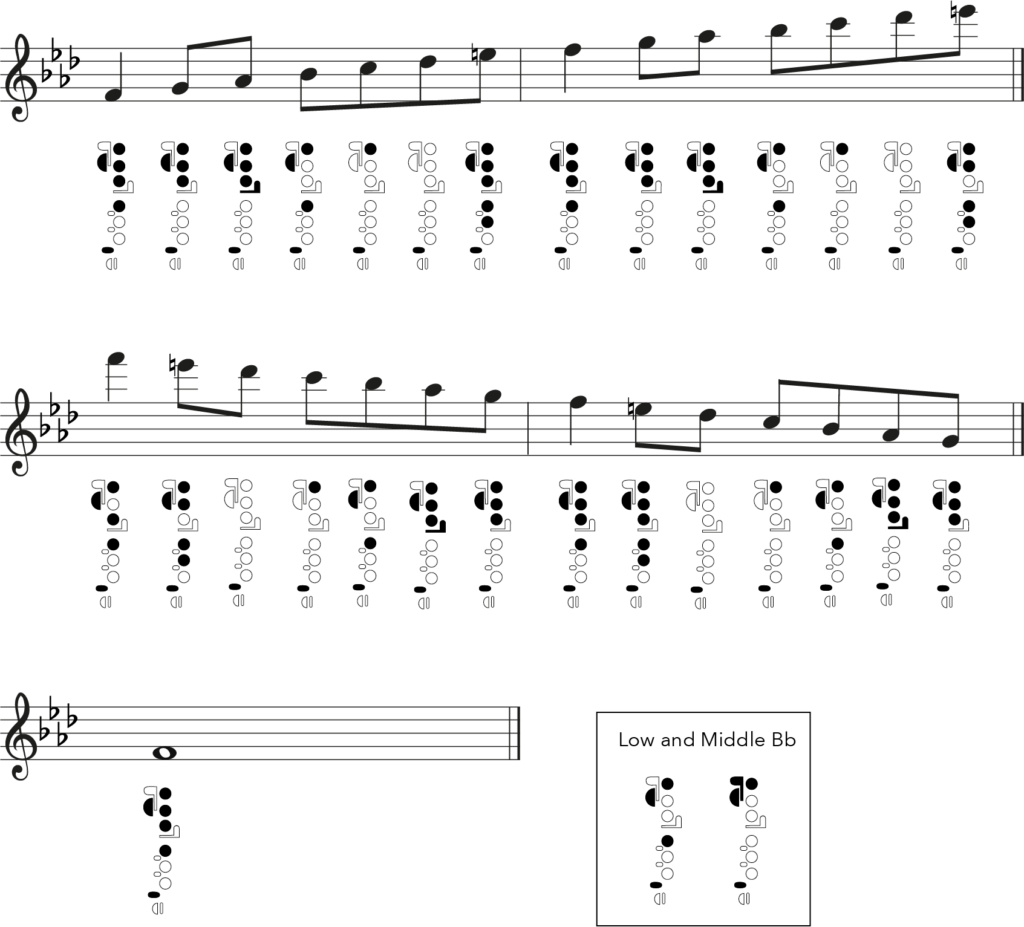
Flute Harmonic Minor Scales- Top tips for F harmonic minor:
- Navigating E to F Transition: Focus on the smooth transition between E natural and F in the F harmonic minor scale. This step involves precise finger movement for a clean sound. Practice moving between these notes slowly, emphasizing accuracy, then gradually increase the tempo while maintaining smoothness.
- Tuning the Raised 7th (E): The E natural, serving as the raised 7th, can be challenging to tune correctly within the scale, often sounding sharp or flat. Use a tuner to practice the E in isolation, adjusting your embouchure to ensure it’s in tune. Then, practice it within the scale, paying careful attention to how it integrates with the other notes, especially the F.
- Consistent Tone Quality across Octaves: Ensure even tone quality and volume throughout the scale, particularly when crossing from the mid to the upper register. Practice with focused air support and a stable embouchure to maintain a consistent sound.
B flat Harmonic Minor
Notes: B♭, C, D♭, E♭, F, G♭, A, B♭
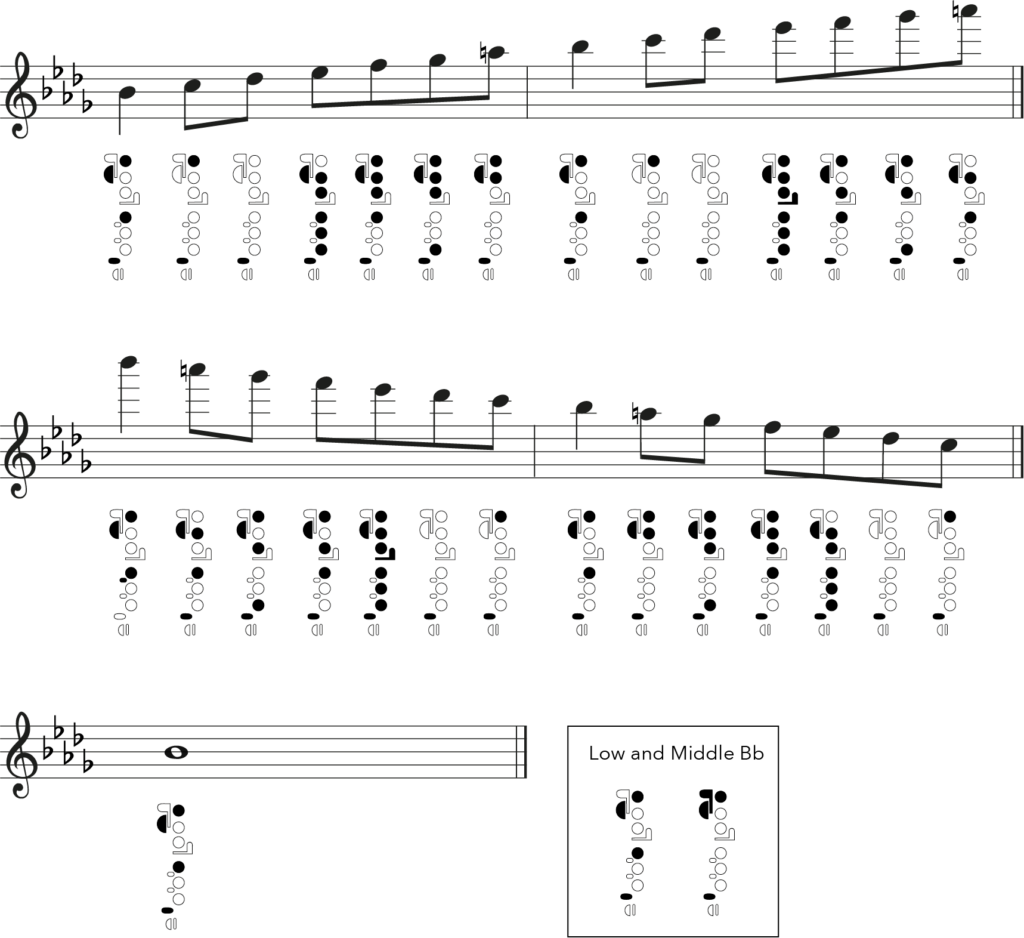
Flute Harmonic Minor Scales- Top tips for Bb harmonic minor:
- Accurate Fingering for G to Ab Transition: The transition from G natural to Ab in the B-flat harmonic minor scale requires attention to clean fingering. Practice moving between these notes slowly to ensure a smooth connection, focusing on the precise lifting and placing of fingers. Gradually increase the tempo as you become comfortable with the transition, ensuring clarity and smoothness remain consistent.
- Tuning the Raised 7th (A): The A natural, acting as the raised 7th, can present intonation challenges, especially in its tendency to sound sharp. Use a tuner to practice this note both in isolation and within the context of the scale, making subtle embouchure adjustments to correct its pitch. Focus on how it integrates with the surrounding notes, particularly when transitioning to and from the B-flat.
- Maintaining Even Tone Across the Scale: Achieving a consistent tone quality across the scale, especially through the octave leap from B-flat to B-flat, is crucial. Focus on steady air support and embouchure flexibility to maintain a consistent sound. Practice the scale in sections, concentrating on the lower and upper octaves separately before combining them.
E Flat Harmonic Minor
Notes: E♭, F, G♭, A♭, B♭, C♭, D, E♭
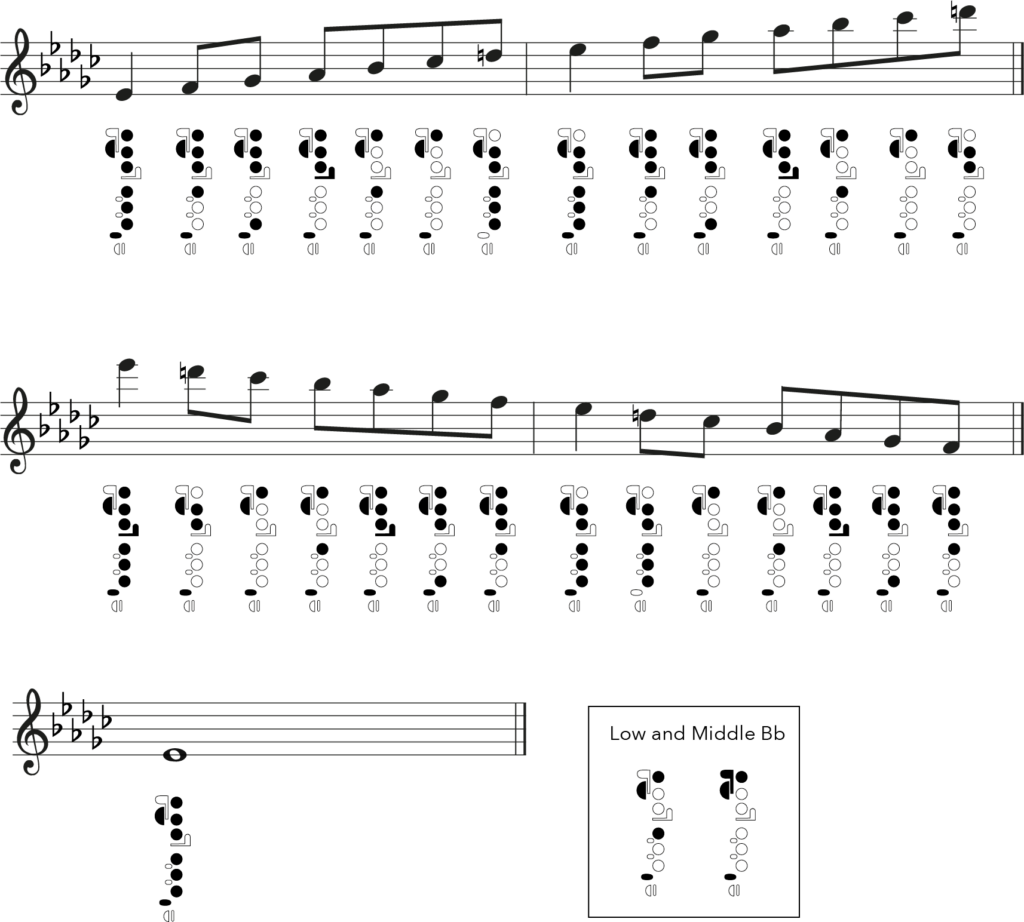
Flute Harmonic minor Scales- Top tips for Eb harmonic minor:
- Smooth Transition Between D♭ and E♭: Focus on the precise fingering required to move smoothly between D♭ and the tonic E♭ in the E-flat harmonic minor scale. This transition can be particularly challenging due to the fingerings and the half-hole technique required for D♭. Practice these transitions slowly, emphasizing clean, clear articulation, and gradually increase the speed as your control improves.
- Tuning the Raised 7th (D): The D natural, serving as the raised 7th, can be difficult to tune, especially when transitioning from C♭ (enharmonically B) to D and then to E♭. Use a tuner to practice the D note in isolation, adjusting your embouchure to correct the pitch. Then, integrate this tuning practice into playing the scale, focusing on the intonation of the D within the harmonic context.
- Consistent Tone Quality in Upper Register: The leap to the high E♭ and maintaining a consistent tone quality across the scale, particularly in the transition from the raised 7th (D) back to E♭, requires careful control of air support and embouchure. Practice playing the high notes separately to ensure rich, full tone quality, then gradually incorporate these into the scale practice.
What’s next….?
- Learn all major flute scale, with finger charts included!
